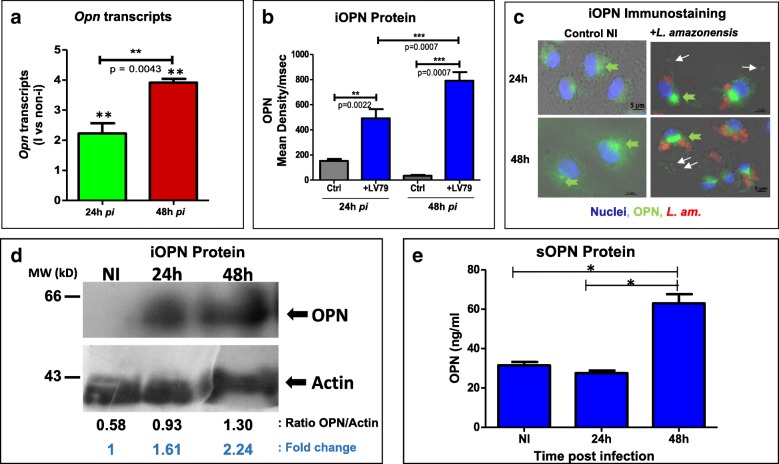Fig. 2.
L. amazonensis parasites stimulate OPN in BMFs. a. Opn transcript concentrations were evaluated by real-time quantitative PCR. Relative quantity of opn transcripts is calculated vs the non-infected (NI) values. At 24 h p.i. NI vs I, P = 0.0022; at 48 h p.i. NI vs I, P = 0.005. b. Mean Density of OPN protein FITC staining with anti-OPN antibody as described in (c). > 10 cells were evaluated per sample. Blue: infected with LV79 amastigotes and gray: non-infected control values. c. Immunostaining of BMFs isolated from C57BL/6 wild type control (NI, Non-Infected) and infected with L.amazonensis amastigotes, at 24 h and 48 h p.i. OPN was labelled with anti-OPN antibodies and revealed with donkey anti-goat FITC (green). The mAb 2A3–26-biotinylated was used for the parasites and revealed with streptavidin conjugated to Texas Red (red). Nuclei are in blue (Hoechst). Green arrows indicate the intracellular OPN, seemingly concentrated in the ER. White arrows indicate secretory granules and sOPN. d. Detection and quantification of intracellular (iOPN) by Western blot analysis of BMF cell extracts from C57Bl/6 wild type mice, non-infected (NI) and infected with the parasites for 24 h and 48 h. 15 μg of total protein extracts were loaded per lane; Molecular weight markers positions are shown on the left of the figure. Below are the OPN/Actin ratio and the fold changes are noted in comparison with the non-infected OPN stain. e. Quantification of the secreted form of OPN (sOPN) in the BMF media (100 μl) at various times post infection by an ELISA assay

